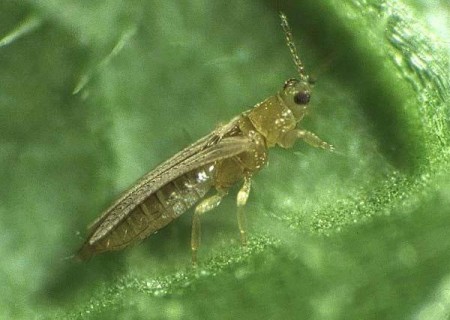Adults and especially thrips larvae are so small that they can only be detected with a magnifying glass. The heads of cabbage spoiled by thrips look beautiful in appearance, but as soon as the first leaves are removed, the favorable impression of the quality of the cabbage changes to the opposite: between the leaves, rusty spots with black spots of pest excrement are clearly visible.

Tobacco thrips
The head of cabbage can be peeled almost down to the stump, but you still can’t get to the intact leaves.Thrips is also dangerous because it is a carrier of viral diseases.
There are many types of thrips. What they all have in common is the presence of blisters on their legs and fringes on their wings. These features help the pest spread over long distances with the help of wind.
Cabbage is most often damaged by tobacco tripe. He also likes to eat onions.
During a season, thrips can produce up to 7-8 generations, and even more in a greenhouse. To successfully combat this pest, you need to know its biology.
Tobacco thrips emerge from wintering in early April. First it feeds on weeds, later it spreads to cultivated plants. Within a few days, the eggs laid by the females hatch into larvae, which in 12-15 days manage to feed, complete their development cycle in the soil and turn into adult insects.
In hot, dry weather, the pest becomes more prolific and voracious. Thrips react to changes in temperature even during the day, always trying to find a warmer place: in the morning it rushes to the top of the head of cabbage, in the evening it moves closer to the base of the leaves. Cold autumn weather forces insects to stay inside the head of cabbage all the time.
The pest thrives in drip irrigation areas. Watering cabbage using sprinkling method sharply reduces its number and harmfulness.
Cabbage is less affected by thrips in areas where the owners constantly get rid of weeds, on which the pest begins to develop in the spring.
After harvesting, it is undesirable to leave plant residues (primarily cabbage, onions) on the beds. It is better to put them in compost and create favorable conditions for “burning”. When exposed to high temperatures, thrips will die and plant debris will turn into compost.The beds after cabbage and onions are dug deeply.
It is also necessary to take into account that the resistance of cabbage to thrips is increased by potassium fertilizers, and be sure to include potassium sulfate and wood ash in the menu.
On our six acres, all the beds are next to each other. And yet, you should try to plant late-season cabbage away from early and mid-season onions.
The selection of varieties also matters. It is believed that the presence of a strong waxy coating and the “strong” structure of the leaves makes cabbage more resistant to pests (for example, the late cabbage hybrid Aggressor).
Beneficial insects reduce the number of thrips: ladybugs, lacewings, hoverflies. And you need to make sure that they are on your site: sow dill next to the cabbage and onion beds, the flowering of which will attract entomophages.
Used against thrips biological drugs (fitoverm), infusions of insecticidal plants (tagetes, pyrethrum, tomatoes, celandine, garlic, hot pepper, etc.).
Of the chemical pesticides used on cabbage, spark M, fufanon-nova. The edges of the beds are treated especially carefully.


 CUCUMBERS NEVER GET SICK, I'VE BEEN USING ONLY THIS FOR 40 YEARS! I SHARE A SECRET WITH YOU, CUCUMBERS ARE LIKE THE PICTURE!
CUCUMBERS NEVER GET SICK, I'VE BEEN USING ONLY THIS FOR 40 YEARS! I SHARE A SECRET WITH YOU, CUCUMBERS ARE LIKE THE PICTURE! You can dig a bucket of potatoes from each bush. Do you think these are fairy tales? Watch the video
You can dig a bucket of potatoes from each bush. Do you think these are fairy tales? Watch the video
 How our fellow gardeners work in Korea. There is a lot to learn and just fun to watch.
How our fellow gardeners work in Korea. There is a lot to learn and just fun to watch. Eye trainer. The author claims that with daily viewing, vision is restored. They don't charge money for views.
Eye trainer. The author claims that with daily viewing, vision is restored. They don't charge money for views. A 3-ingredient cake recipe in 30 minutes is better than Napoleon. Simple and very tasty.
A 3-ingredient cake recipe in 30 minutes is better than Napoleon. Simple and very tasty. Therapeutic exercises for cervical osteochondrosis. A complete set of exercises.
Therapeutic exercises for cervical osteochondrosis. A complete set of exercises. Which indoor plants match your zodiac sign?
Which indoor plants match your zodiac sign? What about them? Excursion to German dachas.
What about them? Excursion to German dachas.